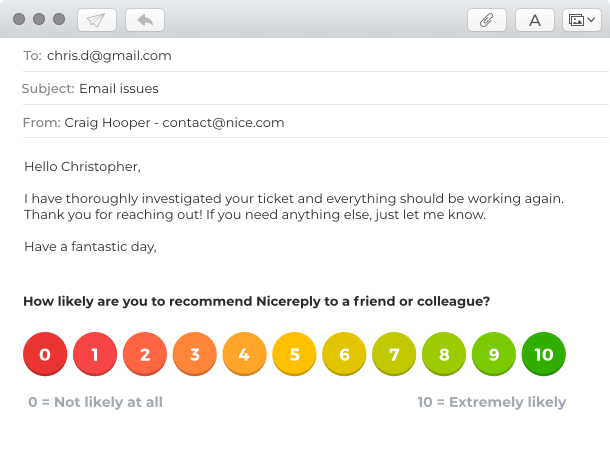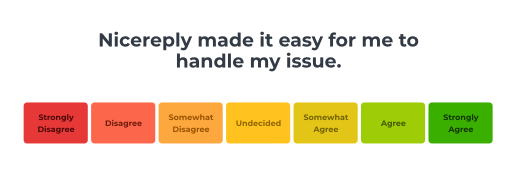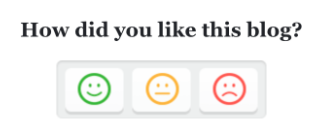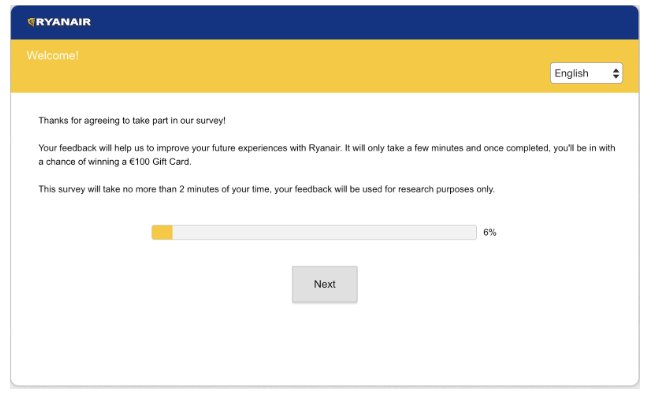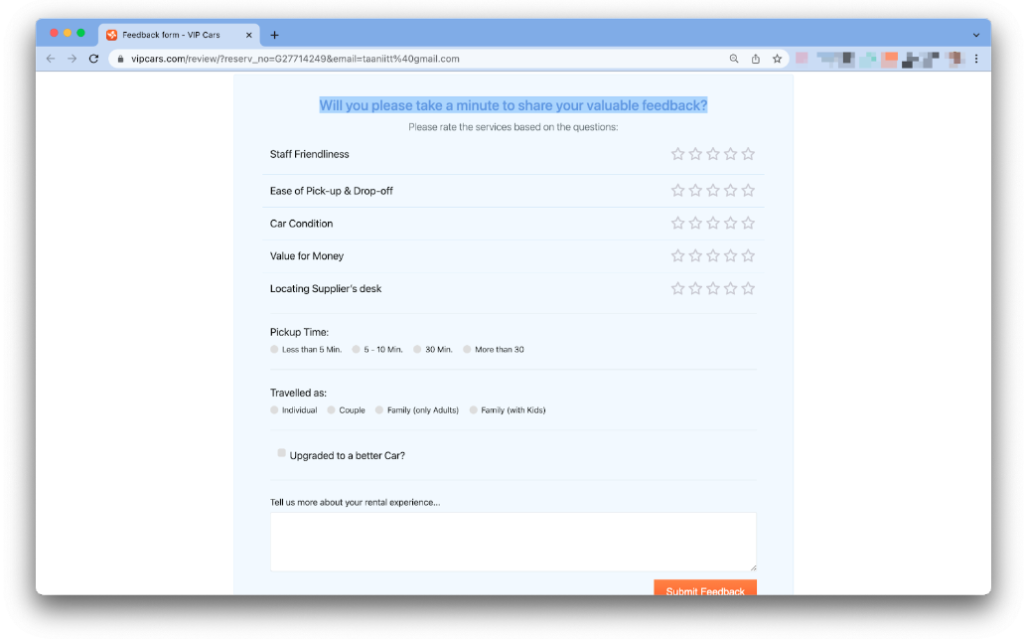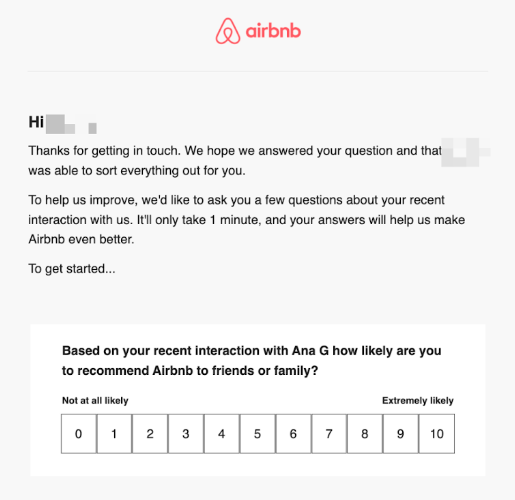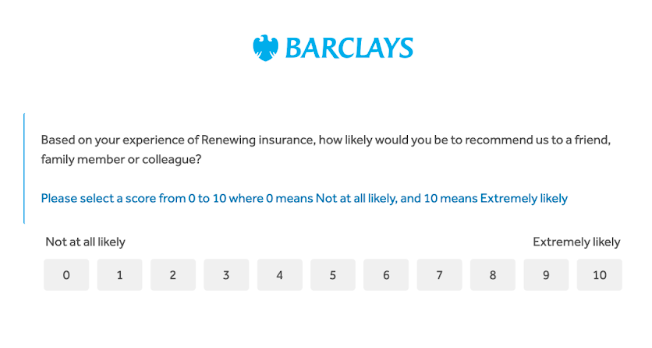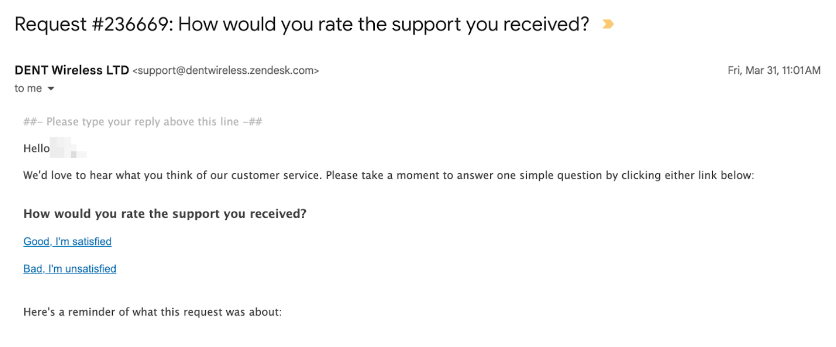A customer satisfaction survey – the easiest way to get feedback from your customers.
Customer feedback fuels the engine of any business.
With actionable feedback, organizations can make informed decisions. When you know what customers think about your product and your service, you’re able to plan strategically and make smart bets.
And the easiest way to get customer feedback is by using customer satisfaction surveys.
Now, there’s no right or wrong approach to customer satisfaction survey questions — it all depends on what you’re trying to understand. That’s why we’ve pulled together this list of essential customer satisfaction survey question examples that you can easily copy or adapt based on your goals.
At the end of the article, we’ve also shared free customer satisfaction survey templates to inspire you as you create your own.
- What is a customer satisfaction survey?
- Why customer satisfaction surveys are important
- Types of customer satisfaction surveys
- 18 key customer satisfaction survey questions
- CSAT questions
- Net Promoter Score (NPS) questions
- Product-Market Fit (PMF) questions
- Customer Effort Score (CES) questions
- Retention and churn questions
- Post-purchase questions
- General product questions
- Best practices for great customer satisfaction surveys
- 1. Use clear and concise language
- 2. Keep it short and sweet
- 3. Use open-ended or close-ended questions (or both)
- 4. Send it at the right time
- 5. Offer an incentive
- 6. Keep your audience in mind
- 7. Follow a logical order
- 8. Show a progress bar
- 9. Test your feedback form internally
- Customer satisfaction survey templates
- Understanding your customers
What is a customer satisfaction survey?
A customer satisfaction survey is a list of one or more questions organizations use to get feedback from customers about their product or service. These surveys can ask about specific features, the customer support experience, or any other area of the business.
Companies use customer satisfaction surveys to understand everything from the smallest of interactions during the customer journey (e.g., “I find this button confusing”) to big-picture issues such as why a customer canceled their subscription.
There are a few ways to measure customer satisfaction. The most common one? Simply asking your customer what they think.
Why customer satisfaction surveys are important
If you’re reading this article, you probably know how crucial customer feedback is in today’s competitive business environment. More than ever, people choose companies with a top customer experience.
Not surprisingly, 96% of customers say customer service is important in their choice of loyalty to a brand. And — according to research from Bain & Company and Harvard Business School — an increase in customer retention by 5% can improve profits by 25–95%.
If customer satisfaction is your goal, constant feedback is the best way to improve it over time.
You need to measure customer satisfaction to verify whether your strategy is working as you planned. Don’t do it, and you risk losing customers along the way.
As a 2022 PWC survey explained, bad experiences — with products, services, or a customer support agent —were the overwhelming reasons people “stopped using or buying from a business.
Customer satisfaction surveys can help you improve in different areas of the business:
- Improve customer loyalty and retention: A sudden decrease in your customer satisfaction (CSAT) survey results might indicate that some of your customers are unhappy. That’s a leading indicator that they might churn in the near future. Figuring out the source of their dissatisfaction before emerging issues become damaging is crucial. Put simply, you can’t improve your retention strategy unless you have a clear understanding of what makes your customers happy. A CSAT survey can help you get that understanding.
- Understand customers’ expectations: A customer satisfaction survey is a goldmine because it gives you access to a pool of customer feedback. It’s a direct line of communication with your customer base. And whether that feedback is good or bad, listening and taking action put customers’ needs at the front and center of the decision-making.
- Deliver products or services customers want: As your product evolves and you release new or improved features, customer satisfaction surveys can help you understand how those features are being received. You’ll gather crucial feedback on what’s working well (or not so well) so that your product is always going in the right direction.
Customer satisfaction is a top differentiator that businesses can rely on in today’s competitive landscape. As the research shows, the businesses that can offer a consistently good customer experience are the ones that customers will stick with for the long haul.
Types of customer satisfaction surveys
The answers you get depend on the survey questions you ask. That means you need to adjust your survey questions based on the situation you want to understand.
The surveys below are the most common customer feedback forms you can find, but don’t feel restricted — you can always combine or modify them based on your needs:
- CSAT: CSAT stands for customer satisfaction. It measures customer satisfaction with a product, service, or customer support interaction by asking: “How satisfied are you with [company]?” In this survey, you ask people to rate their satisfaction on a scale (e.g., 1–5 or 1–10). The customer satisfaction score is then calculated by dividing the number of satisfied customers by the total number of respondents and multiplying it by 100.
- NPS: Net Promoter Score (NPS) surveys measure loyalty and satisfaction by asking customers how likely they are to recommend your product to others. Respondents rate their willingness to recommend on a scale of 0–10. The NPS score is obtained by subtracting the percentage of detractors (0–6 scores) from the percentage of promoters (9–10 scores).
- CES survey: Customer Effort Score (CES) measures how much effort is required from a customer to use a product or service on a scale of “very easy” to “very difficult.” The respondents rate how much effort it takes to solve an issue or do a task (for example, from 1–5 or 1–10).
- Churn or retention surveys: A churn survey asks why a customer stopped using your product or service. For example, if a customer decides to stop using your service and clicks on the “cancel subscription” button, you would ask them several questions to learn more about their decision to leave.
- PMF survey: A product-market fit (PMF) survey measures your product or service’s importance and relevance to customers, validating its desirability. PMF surveys ask customers how they’d feel if they could not use your product anymore. The score is a percentage of all responses that picked “very disappointed” from the total amount of responses.
- Post-purchase feedback surveys: This survey is sent to customers shortly after buying a product to learn more about their shopping experience, product quality, and any issues that might arise. A post-purchase feedback survey typically will combine NPS, CSAT, and CES questions.
Milestone surveys: A milestone survey is a type of customer satisfaction survey conducted at specific points during a customer journey to improve those interactions. They can be time-based — for example, if you send it 30 days after account creation — or event-based, such as after downgrading a membership.
18 key customer satisfaction survey questions
When you’re starting to measure customer satisfaction, you’ll probably begin by using the default functionality of your support help desk tool. But there are other crucial customer satisfaction survey questions you should consider as your customer feedback program evolves.
For example, if you want to understand customer satisfaction, a key question would be, “How would you rate the support you received?” Similarly, if you’re sending an NPS survey, questions would have a 0–10 scale and be in the form of, “How likely would you be to recommend our service to friends or family?”
The right types of questions to ask are contextual, but we always recommend asking at least one open-ended question. What users tell you outside of a closed scale might surprise you!
In the list below, we’ve organized examples of customer satisfaction survey questions based on the type of survey they belong to. Of course, you can mix and match these questions in one survey depending on your area of research.
CSAT questions
- How would you rate the support you received?
- Please rate the product/services you’ve purchased/received.
- How would you rate your experience across the following areas?
Looking for more Customer Satisfaction Survey Samples? Check out one of our most favorite resources!
Net Promoter Score (NPS) questions
- Based on your experience with our product/service, how likely would you be to recommend us to a friend, family member, or colleague?
- Based on your recent interaction with [Customer Support Agent], how likely would you be to recommend our product/service to friends or family?
Product-Market Fit (PMF) questions
- How would you feel if you could no longer use our product/service?
Customer Effort Score (CES) questions
- How easy did our product/service/organization make it for you to solve your issue?
- How well does our product/service meet your needs?
Retention and churn questions
- How likely are you to buy from us again?
- What’s the main reason you are canceling/downgrading/returning this item?
Post-purchase questions
- What improvements would you like to see in our product/service?
- Have you encountered any problems while using the product/service? If yes, please describe them.
- How, if at all, has your perception of our product/service changed following your latest experience?
- How likely are you to purchase from us again in the future?
General product questions
- On a scale of 1–10, please rank the following features of our product/service in order of how frequently you use them, with 1 being the most frequently used.
- What do you like most about the product/service?
- How well did our product/service meet your expectations?
- How was your experience with our product/service?
Start your day
with great
quality
content
Best practices for great customer satisfaction surveys
Ultimately, when coming up with customer satisfaction survey questions, the one thing to keep in mind is that you need to create something that customers want to answer.
When you’re creating your feedback form, be sure to make it as easy as possible for people to complete the form. Aim for low effort. Any extra clicks, mandatory questions (especially if they are open-ended), or images that take too long to load will diminish the success of your survey.
Your survey’s success depends on the quality of the responses from your customers. Here are our best recommendations to achieve that:
1. Use clear and concise language
Unless customers clearly understand what you’re asking, you won’t be able to get honest answers. The best way to do that is by asking straightforward questions and simplifying your survey as much as possible.
For example, keep your sentences short, use active verbs, and avoid jargon or technical language. If you struggle with how to do this, check this guide to writing in plain English.
Notice the straightforward questions from the example above. This tour company chose to make most questions optional and only keep what is strictly necessary as mandatory (the overall rating for the activity).
2. Keep it short and sweet
Create customer satisfaction survey questions that are as focused as possible. Your survey should only contain the questions you need to fulfill your goal.
Remember that the easier a form is to fill in, the more responses you’ll typically receive.
For example, at Nicereply, we consistently ask a simple question at the end of every blog article. The goal is to determine whether our readers found the post helpful. That feedback contributes to our end goal of creating great content that helps customer support leaders and teams.
For this reason, we ask a simple question:
Only ask questions that relate to your end goal. Nobody wants to waste time on overly complicated surveys with duplicated questions, and your customers are no exception!
3. Use open-ended or close-ended questions (or both)
Once you know the goal of your survey, you need to choose the best type of questions to reach that goal.
All customer satisfaction surveys should begin with a quantitative question that asks customers to assign a numerical value to the product or service. For example, how satisfied are your customers from 1 to 5?
This is a close-ended question, and it gives you quantitative data that you can use to easily and consistently measure customer satisfaction.
Often, the more helpful part of a survey comes when using qualitative or open-ended questions. These questions don’t limit customers to a certain format. They remove the boxes and enable customers to share whatever they think or feel.
The bottom line? Ask customers to share their experiences to get more information and insight through open-ended questions. While it takes more time to process, open-ended feedback is a treasure trove of information for your business.
It’s one of the best ways to hear firsthand what your customers feel about your business.
4. Send it at the right time
Finding the right time to send a survey is a matter of experimentation.
You don’t want to send a post-purchase survey so close to the purchase that your customer hasn’t received the goods, but you also don’t want to wait so long that they forget entirely about the experience.
A simple way to send surveys at a specific time is by using automated triggers.
Here’s one example: Many customer support teams like to send customer surveys directly after a support interaction ends.
To achieve that, you could use a tool like Nicereply to integrate with your ticketing system and automate these surveys by using a trigger that sends the survey email when certain criteria are met — like a ticket being closed. Automating surveys across your entire customer base helps ensure unbiased feedback and reduces the effort on your support team.
5. Offer an incentive
Incentives can be a mixed bag when it comes to customer feedback. In some situations, they can encourage participation.
That being said, they can also increase bias or skew your results. If you’re offering a gift card, you’re more likely to get responses from users who could really use a gift card right now. You also might see that they tend to share more positive feedback, because they may assume that positive feedback is more likely to help them get the incentive.
While you need to be careful not to rely on incentives for feedback, they can be a useful tool in some situations. For instance, this example from Ryanair could generate extra feedback, but since completing the survey only enters the user into a drawing for a prize, it’s less likely to skew the results.
6. Keep your audience in mind
Who will answer your feedback form depends on many factors, such as the time you send it, its length, the type of questions you ask, and more.
For instance, you’ll see different results sending the survey via email than you would as a survey pop-up on your website.
The example below from a car rental company is aimed at the customers that rented a car with them. If you had just been browsing their website or if the rental had been canceled, the survey wouldn’t make any sense.
Another thing to notice: See how they leave space at the end of the survey to collect valuable open-ended feedback?
7. Follow a logical order
Your feedback form should have a logical flow. Don’t ask for product experience feedback after a user responds that they’ve never used your software.
For longer surveys, it’s often helpful to create a spreadsheet with the types of questions (multiple choice, Yes/No, free text, etc.) and the logical ordering (for example, if the answer to question 6 is > 7, jump to question 9).
Your customer survey tool may also include functionality that helps you map out the user’s experience in a logical way.
8. Show a progress bar
Not all surveys need a progress bar, but if your survey involves more than two or three questions, it’s smart to add one. Most people who take time out of their day to start a survey would like to finish it. By showing a progress bar, you’ll give customers a better feeling of how long they’ll need to complete it.
Imagine you’ve completed five questions and only have one left. You’ll likely make that extra effort to finish it, right? However, if you have no clue how many questions are waiting for you — maybe two, maybe twelve — then you’re more likely to drop out.
It’s also super helpful to let users know how long it’ll take to complete your feedback form. This transparency sets clear expectations for your customers.
9. Test your feedback form internally
Asking a few colleagues to test your customer satisfaction survey might seem like a waste of time, but we highly recommend it.
By taking your survey on a test drive before it’s shared with the real world, you’ll ensure mistakes — big or small — are fixed. By doing so, you’ll ensure your customers only get the best possible version of your survey.
Customer satisfaction survey templates
We’ve seen how to create great customer satisfaction surveys. Now let’s see what it looks like when you put all those tips into action.
The following customer satisfaction survey templates show you some of the best customer satisfaction survey questions. We’ve also included some templates created with Nicereply, such as the CSAT and NPS score surveys.
If you’re ready to create your survey right now, here are a few top customer satisfaction survey templates you can use with your favorite customer feedback tool.
General product satisfaction survey template

Say goodbye to boring templates and get product insights with our brand new Website Popup surveys! Try a free 14-day trial now. Click below and discover more!
(Bonus) Customer Satisfaction Survey Examples
Curious to see how other brands have implemented some of the questions we’ve mentioned in this article? We’ve compiled recent examples from businesses across different industries.
Airbnb Survey
Barclays Survey
DENT Wireless Survey
Understanding your customers
If you want to know what customers think of you, all you have to do is ask them!
Customer satisfaction surveys are a powerful tool in your brand’s fight to win customer loyalty. With the feedback they provide, you can improve your product, your customer service, and the overall customer experience — leading to higher revenue and more loyal customers.
Asking your customers for feedback — combined with other data sources, like your support tickets — will help you shape the evolution of your business.


